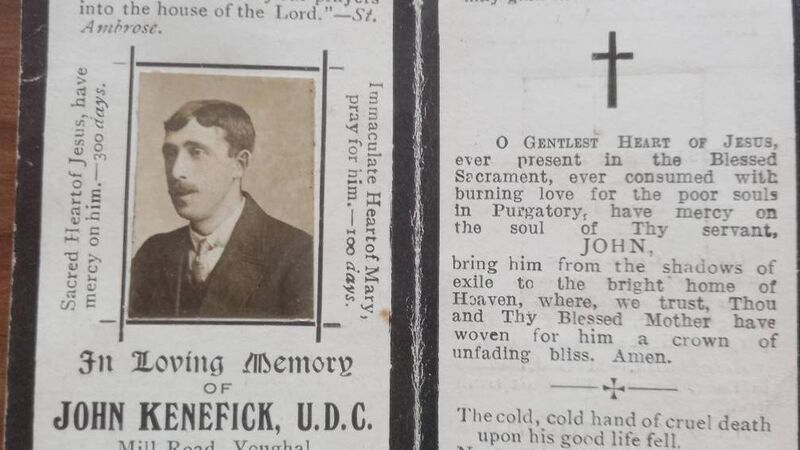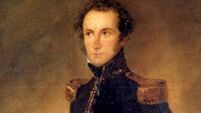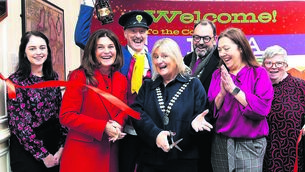Youghal patriot to be remembered in his home town

A funeral card in remembrance of Johnny Kenefick, a Sinn Féin councillor a century ago
It’s hard to imagine now, how a Sinn Féin rebel - an elected member of Youghal Urban Disrict Council - defied capture by the British authorities for six years during the early 20th century.
Johnny Kenefick was born in 1888 and, as a young boy, he witnessed many evictions during the Land league campaign of the late 1800s.
This had a big influence on him, and he began to move towards the Volunteers of the IRA. He joined up, and soon became a wanted man.
Being on-the-run meant he was unable to sleep at home for fear of arrest.
During the fight for independence, all the dwellers in a house had to be listed on the back of the front door in case the soldiers called.
The list was often checked, and any irregularity between the list of names and those asleep in the house meant an arrest.
One story told of a neighbour of Johnny’s sheltering him one night.
This neighbour’s brother happened to be up the road playing cards, while Johnny was asleep in his bed. When the soldiers entered the house and checked the list of dwellers, they saw the man in bed and believed him to be the brother. Johnny had a narrow escape.
In the elections held in 1918, Sinn Féin swept the board and Johnny Kenefick was elected to Youghal Urban District Council.
This was remarkable as he was a wanted man on-the-run, and so could not show his face at any campaigning.
Despite this - such was the support of the people for him, that he was elected in his absence. Of course, he could not take his seat on the council for fear of arrest.
In those troublesome years, Johnny ate and slept where he could safely do so.
The folk living in the countryside were especially helpful - often hiding him in a loft or an outhouse.
But there was a terrible downside when the winter came and the weather got bad. Not being able to reach a safe house then meant sleeping in a wet ditch or on top of the kilns at the local brickyard, where you had some heat.
It was from sleeping in wet clothes on those kilns that Johnny got pneumonia. He developed the dreaded TB - for which there was no cure at the time.
He continued to be sheltered at great risk by his supporters during his sickness, but on June 13, 1922 (not long before the treaty) Johnny succumbed.
His funeral was led by the Cork Hill Pipe Band from his home at Mill Road to North Abbey Cemetery. It was just a short distance of 300 yards, and he was then buried in an unmarked grassy grave - where recently only the elderly of the town could identify it.
His comrades were buried nearby in the Republican Plot - all were shot in different circumstances - but because Johnny died of TB, he slipped until the radar and was buried in a different spot.
Now, after 103 years - Johnny Kenefick will have a gravestone to remember him and show where he lies.
Johnny was my grand-uncle that I never met. He had one brother who went to America as a young man but was never heard from afterwards.
Johnny had four sisters including my grandmother Ellen Hackett - who also died of TB, during the Eucharistic Congress of 1932.
Other sisters were Maggie (Swayne), Katie (Duggan) and Hanny (O’Sullivan).
My grandfather Micky Hackett told of going to the country on Sundays with pals and dogs to hunt rabbits. This was a ruse to get some supplies to the rebels in the woods. Johnny Kenefick was his brother-in-law.
The magnificent Ballynatray House on the River Blackwater was owned and lived in by Captain Holroyd Smyth and his family during that early 20th century. His wife was very sympathetic to those hungry young men and often fed them behind her husband’s back.
Then, later, when a lot of fine houses were being torched by the rebels - Ballynatray was left intact.
This Sunday, September 14, the very same Cork Hill Pipe Band (now named the Youghal Pipe Band) that played Johnny’s remains from his home to the graveyard at North Abbey in 1922, will re-enact that funeral procession preceded by a colour party of flags.
On reaching North Abbey, a gravestone bearing a small tricolour in one top corner and the Republican flag with the yellow harp on the other corner, will be unveiled to Johnny’s memory.
Incidentally, the band was founded in 1914 by Danny Duis McCarthy, who was also a Volunteer in the IRA.
In those early days, he would dry goat skins for the drums and use split sally twigs for drones in the bagpipes.
We must congratulate this band on becoming the fourth best in the world at the World Pipe Band Championships in Scotland recently. Their drum section was judged to be the third best in the world.
This is a long way from the band that Danny Duis McCarthy founded in 1914 on a shoestring budget.
Everybody is invited to join in this short parade on Sunday - starting at the Mill Road roundabout at 11am - and then, following the unveiling, to meet with the extended Kenefick family for light refreshments at Hennessy’s Bar on 18, South Main Street, Youghal.







 App?
App?




